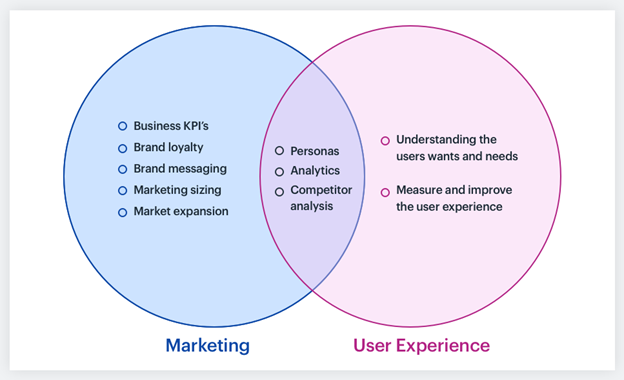In the fast-paced digital age, where competition is fierce and consumers’ attention spans are shorter than ever, businesses must find ways to stand out. User Experience (UX) design has become one of the most critical components of successful marketing strategies. In today’s market, it’s no longer enough to offer excellent products or services; the overall experience a customer has with a brand is just as important, if not more so. The integration of UX into marketing strategies has a profound impact on customer engagement, retention, and loyalty.
User Experience (UX)
User Experience (UX) refers to how users interact with a product, website, or service and their overall experience during that interaction. It encompasses several elements, including usability, accessibility, aesthetics, and overall satisfaction. UX is about creating seamless, intuitive, and enjoyable experiences for users that meet their needs and exceed their expectations.
In the context of marketing, UX focuses on guiding users through the buyer’s journey in a way that is smooth and engaging. When UX is well-designed, users are more likely to stay longer on a website, interact with the brand, and, ultimately, convert into loyal customers. In contrast, poor UX can frustrate users, leading them to abandon a website or product before completing a purchase, negatively impacting conversion rates.
The Importance of UX in Digital Marketing
Digital marketing revolves around attracting and retaining customers, driving conversions, and fostering brand loyalty. UX plays a critical role in this process because it directly impacts how consumers perceive a brand. When a business incorporates strong UX principles into its digital marketing efforts, it enhances the customer journey by making it as straightforward, accessible, and enjoyable as possible.
One of the main reasons UX is so essential to marketing is that it is deeply tied to first impressions. When users visit a website or interact with a digital product for the first time, they form an opinion about the brand within seconds. A website that is visually appealing, easy to navigate, and loads quickly is likely to leave a positive impression, while one that is cluttered or difficult to use will drive potential customers away. In fact, studies show that 88% of online consumers are less likely to return to a site after a bad experience.
Moreover, UX is crucial for SEO (search engine optimization). Search engines like Google reward websites that prioritize a good user experience, including mobile responsiveness, fast loading times, and easy navigation. As a result, websites with strong UX designs are more likely to rank higher in search results, attracting more traffic and visibility, which is essential for any marketing strategy.
How UX Enhances Customer Engagement
Customer engagement is a core goal of any marketing strategy, and UX plays a pivotal role in fostering that engagement. A well-designed UX encourages users to explore a website or app further, interact with content, and ultimately engage with the brand.
By providing a seamless experience, UX reduces friction points that could deter users from completing desired actions, such as filling out a form, making a purchase, or subscribing to a newsletter. For instance, simplifying the checkout process, making it mobile-friendly, and offering clear navigation options can significantly increase the chances of users completing a transaction.
A key aspect of UX is also anticipating the needs of the user and delivering content or actions that align with their intentions. Personalized experiences, where users receive tailored content or product recommendations based on their behavior or preferences, can significantly boost engagement. In this way, UX not only keeps users engaged in the moment but also encourages repeat interactions, driving long-term customer relationships.
UX and Brand Loyalty
Successful marketing is not just about attracting new customers but also about retaining them and building lasting relationships. UX is a powerful tool for fostering brand loyalty by ensuring that users have a positive, memorable experience each time they interact with a brand.
Consistency in UX design helps build trust and reliability. When users know that they can rely on a brand for a smooth, intuitive experience, they are more likely to return and make repeat purchases. Consistent experiences across different touchpoints, such as websites, mobile apps, and social media platforms, help reinforce a brand’s identity and ensure that users have a cohesive experience, regardless of the channel.
Additionally, UX design contributes to emotional engagement. By creating a user experience that resonates with the emotions and values of the target audience, brands can establish stronger connections with their customers. For example, incorporating elements of storytelling into UX design can evoke emotional responses, creating a more profound connection between the user and the brand.
Brands like Theelitefirms have successfully leveraged UX to enhance customer loyalty. By focusing on creating a frictionless experience that meets the needs of their audience, they’ve fostered deeper engagement and long-term relationships with their customers. Incorporating UX into marketing strategies can transform occasional customers into loyal brand advocates, increasing lifetime value and generating positive word-of-mouth.
The Role of UX in Driving Conversions
One of the primary goals of any marketing strategy is to drive conversions. Whether a business is looking to increase sales, grow its email list, or generate leads, UX is integral to achieving those goals. A seamless user experience ensures that potential customers can easily find the information they need, understand the value of a product or service, and complete the desired action without unnecessary obstacles.
For example, optimizing a landing page with clear call-to-action (CTA) buttons, minimal distractions, and straightforward navigation can significantly improve conversion rates. When users don’t have to struggle to figure out what step to take next, they are more likely to follow through on their intentions, leading to higher conversion rates.
In e-commerce, UX elements such as user-friendly product pages, streamlined checkout processes, and mobile-optimized designs can make a huge difference in converting visitors into paying customers. Each stage of the buyer’s journey should be designed with the user in mind, ensuring that the experience is as intuitive and enjoyable as possible. Marketing efforts are wasted if a business succeeds in attracting users but fails to convert them due to poor UX.
Measuring the Impact of UX on Marketing Success
To truly understand the impact of UX on marketing, it’s essential to measure its effectiveness using key performance indicators (KPIs). Metrics such as bounce rates, time on site, conversion rates, and customer satisfaction scores can provide valuable insights into how well a brand’s UX design is performing.
Analyzing these metrics allows businesses to identify pain points in the user journey and make data-driven decisions to improve the experience. For example, a high bounce rate might indicate that users are struggling to navigate a website, leading them to leave before engaging with the content. By continuously testing and optimizing the UX, businesses can ensure that their marketing efforts are supported by a user-friendly experience, maximizing their impact.
Additionally, tools like heatmaps, A/B testing, and user feedback surveys can provide further insights into how users interact with a brand’s digital assets. By leveraging these insights, businesses can fine-tune their UX design to better align with the needs and expectations of their target audience.
Final Words
In today’s digital landscape, where consumers are more informed and discerning than ever, UX plays a central role in the success of marketing strategies. It is no longer sufficient to focus solely on attracting customers; businesses must also ensure that the experience they provide is intuitive, enjoyable, and frictionless.
From enhancing customer engagement to driving conversions and building brand loyalty, UX is essential to every aspect of a successful marketing strategy. Brands that prioritize UX are more likely to build strong, lasting relationships with their customers, resulting in higher satisfaction and long-term success. As brands like elitefirms have demonstrated, integrating UX into marketing strategies is not just beneficial but necessary for standing out in today’s competitive market.
Ultimately, UX is about creating value for the user, and when businesses prioritize the needs and expectations of their audience, they lay the foundation for lasting success. By making UX a core component of their marketing efforts, businesses can drive better results, foster deeper customer connections, and ensure their brand thrives in the digital age.



